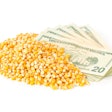
Railroads play a critical role in moving harvested grain to domestic markets and to export ports. Poor rail service during harvest can force farmers and shippers to miss marketing opportunities.
Poor service can also result in lost grain, due to backups, overflowing bins, and rotting from storing excess grain on the ground. A confluence of grain rail supply and demand factors threatens to complicate rail service for the upcoming harvest.
To shed more light on these conditions, this article reviews some recent trends in the supply and demand for grain rail transportation.
Carloads and Secondary Market Bids Reflect Rising Rail Demand
Rail tariff rates typically change too slowly to reflect recent trends. On the other hand, rail volumes and prices in the secondary railcar market respond faster to changes in rail supply and demand and, thus, can indicate current market conditions.
Examining volumes and prices together can provide insight into whether markets are changing because of supply or demand factors. Recently, grain rail volumes and secondary market prices have both increased, reflecting greater demand for rail transportation. Grain carloads originated by U.S. Class I railroads have trended up since early July. Average weekly grain carloads in August were 9 percent above July (GTR figure 3).
Likewise, bids in the secondary market have increased significantly in recent weeks. Bids for delivery of railcars in October traded around $200 per car in May and early June, but are now over $1,000 per car, about $800 above the prior 3-year average.
As of the week ending September 3, prices for delivery of railcars in September and October are above average, about +$800 (per car) in September and +$700 in October. Bids for delivery of railcars in November have fallen considerably in the last 2 weeks from a peak during the week ending August 20.
Grain Supply and Demand Factors
Behind the Rising Demand for Rail Transportation The demand for rail transportation positively correlates to both the supply of and demand for grain itself. On the supply side, grain harvest projections suggest a large demand for rail in the near future.
In its August World Agricultural Supply and Demand Estimates Report (WASDE) report, USDA projected the 2020 harvests would bring record corn production and near-record soybean production. Likewise, demand for grain has been high. Figure 1 shows outstanding grain export sales have grown considerably in recent weeks— particularly, to China, but elsewhere around the globe as well.
As of the week ending August 27, than the same time last year. Outstanding export sales represent sold volumes that have not yet shipped and, thus, indicate future transportation demand. Railroads are one of the major providers of transportation for grain destined for export markets.
China imports U.S. grain both from the Pacific Northwest (PNW), which is largely supplied by rail, and from the Mississippi Gulf, which is largely supplied by barge. Despite the higher costs of rail, the demand for barge transportation could be weakened by the temporary closure of the Illinois waterway through October 13. Thus, demand for rail transportation (as reflected in higher secondary railcar prices) may have increased partly because shippers anticipate more limited barge availability than in previous years.
Recent Railroad Performance
In addition to changes in grain rail demand, railroads have also recently seen significant changes in demand from other commodities.
Figure 2a shows the week-to-week change from February in originated carloadings by commodity. The drop in traffic of non-grain commodities, such as motor vehicles, from March to June, reflects COVID-19-related declines in economic activity across the country. However, since then, much of that traffic has come back online and appears to have hindered grain rail performance. Figure 2b shows a variety of grain rail service metrics indexed to February.
Figures 2a and 2b highlight the recent correlation between total traffic and grain service. To the extent rail traffic continues to return, it could further add to grain rail service challenges during harvest. However, it is worth noting some of the indicators — “grain origin dwell” and “grain car unfilled orders” — have fallen somewhat over the past two weeks.
Contacts: [email protected]; [email protected]; [email protected]
Information provided by the USDA Grain Transportation Report.


















